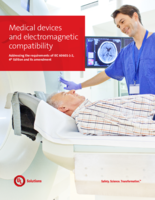
IEC 60601-1-2, 4th Edition Medical devices and electromagnetic compatibility

In 2015 the International Electrotechnical Commission (IEC) published the fourth edition of IEC 60601-1-2, a collateral standard that provides the requirements for essential performance and basic safety in the presence of electromagnetic disturbances. The standard introduces electromagnetic (EM) environments of "intended use", including professional healthcare facilities and home healthcare.
The fourth edition replaces the “life support” and “non-life support” classifications used in the third edition with three intended use environments: 1. professional healthcare facilities, such as hospitals, clinics and other medical facilities; 2. home healthcare settings; and 3. special environments, such as industrial zones and military installations. This change harmonizes the intended use locations of the revised standard with those found in other collateral and particular standards in the IEC 60601 series.
As previously noted, the fourth edition applies the principles of the risk management approach presented in edition 3.1 of IEC 60601-1 (the current edition) to medical device safety issues. Specifically, the standard now requires manufacturers to conduct a risk assessment of the safety issues related to EMC in connection with each medical device, consistent with the requirements of ISO 1497, Medical devices – Application of risk management to medical devices. This risk assessment must cover the specific operating conditions and test levels anticipated in the device’s intended use environment.
The risk management process is also intended to define the essential performance and basic safety requirements of a given device. Pass/fail requirements related to specific emissions and immunity limits are now designed to help ensure that essential performance and basic safety will not be compromised by the “reasonably foreseeable” maximum level of electromagnetic disturbances in the intended use environment.
To address an increase in the threats of damage related to device exposure to electrostatic discharge (ESD), ESD immunity levels under IEC 60601-1-2, 4th Edition, have been significantly increased. In addition, the methodology for evaluating connectors for their immunity to ESD has been modified.
As previously noted, an important motivation for the revision of IEC 60601-1-2 was the increased use of wireless technology either integrated into a medical device or in devices and equipment used in close proximity to medical devices. As a result, the fourth edition modifies the specifications of tests and test levels used to determine the effects of radiofrequency (RF) communications on a given device.
The fourth edition also includes changes to the specifications of immunity test and test levels according to the available ports of the medical electric equipment or system. For example, for most tests, immunity testing is now conducted at only a single line voltage instead of two, as previously specified.
The fourth edition now excludes from immunity testing I/O cables that are less than three meters long. However, it is important to note that regulators in some jurisdictions may not recognize this exclusion, and may require all I/O cables to undergo immunity testing regardless of their length.
The fourth edition now stipulates that information technology equipment (ITE), such as computers, laptops and tablets that function as an essential component of a medical device or system and which can affect the device’s essential performance, must also meet the relevant EMC requirements of the standard.
The test plan requirements in IEC 60601-1-2, 4th Edition are likely to place a new and significant burden on many device manufacturers seeking to achieve compliance with the standard. Appropriately, the fourth edition includes a number of informative Annexes that provide guidance in understanding many aspects of the test plan requirements and other provisions of the standard, as well as how those requirements should be applied to their particular medical device.
Here is just a sampling of the topics addressed in the nine Annexes in the fourth edition:
Guide to marking and labeling requirement for ME equipment and systems (Annex B)
Similar to guidance documents issued by the U.S. FDA, the Annexes in the fourth edition are intended to be informative in nature, and are not a substitute for the actual requirements detailed in the standard. Device manufacturers can follow the recommendations contained in the Annexes or employ alternative approaches as long as they satisfy the essential requirements of the standard.
UL's EMC experts provide testing for EMC, wireless and other relevant protocols.

IEC 60601-1-2, 4th Edition Medical devices and electromagnetic compatibility